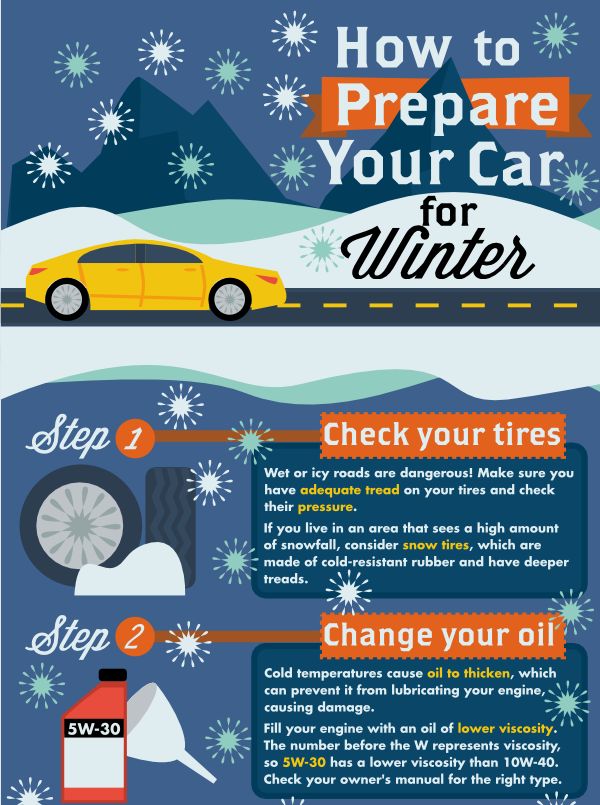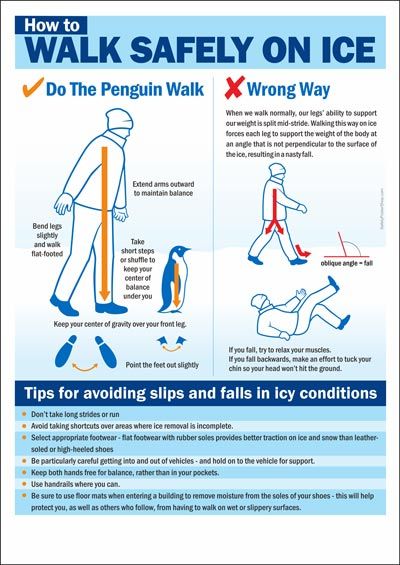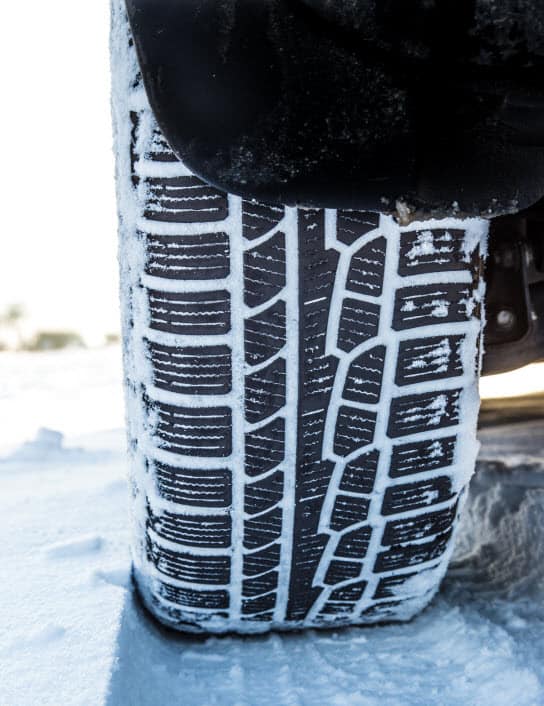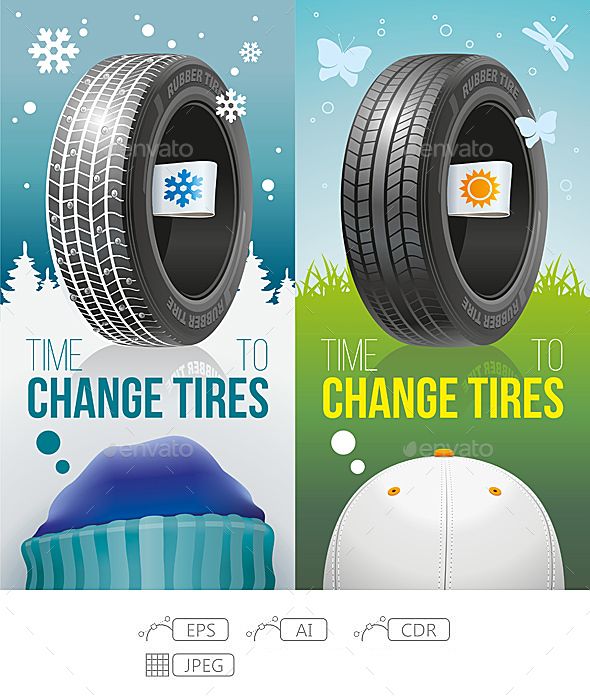By Tom Krishner, The Associated Press
It’s time to get some traction.
At any time now, snow could fall over a broad swath of America, and that means your tires need to be checked.
Experts say if the rubber is worn, you could slide, crash or get stuck, even in a light snowfall. Depending on where you live and how badly you need to get someplace in bad weather, you might want winter tires. All-season tires might be an option, but they won’t start and stop as well in ice and snow.
Experts say late October is a good time to shop for tires and get them installed so you’re ready. Here’s how to figure out whether you need new tires and tips from experts on what kind of rubber to buy:
Check the tread depth: Stick a quarter into the tire grooves at several spots with George Washington’s head upside down. If you can see the top of Washington’s hair, you have 4/32 of an inch of tread or less. That means it’s about time to replace your tires. You may have a little time left in warm, dry weather, but tires with less than 4/32 won’t grip well in ice and snow. People used to use a penny to check tread depth. But if the top of Abraham Lincoln’s head can be seen, that means you’ve only got 2/32 inches of tread left. “At that point most tires are basically worn out and need to be replaced immediately,” says Gene Petersen, tire program manager for Consumer Reports, which does extensive tire testing.
Winter or all-season? It depends on where you live, how urgently you need to be somewhere in the snow, and whether your vehicle is 2-wheel-drive or all-wheel-drive. In an area with moderate snowfall, you probably can get by with all-season tires, especially if you can wait for plows to clear roads before going anywhere. Generally, if you live south of Cincinnati, Ohio, then all-season tires should work, says Woody Rogers, director of tire information for Tire Rack, an online tire store in South Bend, Ind. But to the north, where heavy snowfall is more likely, winter tires will be better. If the engine powers all four of your wheels, good all-season tires may suffice. Generally, winter tires on a two-wheel-drive vehicle grip better than all-season tires on a four-wheel-drive vehicle. Experts say all-wheel-drive makes a big difference starting off in snow. But it won’t help you stop in snow. That’s where winter tires come in. They’ll stop faster in slippery conditions because they grip ice and snow better due to specially designed soft tread compounds. In bad weather, winter tires grip almost like they’re being driven on dry roads, says John DiPiazza, part owner of A&A Tires in Milwaukee. “It’s quite amazing,” he says.
But to the north, where heavy snowfall is more likely, winter tires will be better. If the engine powers all four of your wheels, good all-season tires may suffice. Generally, winter tires on a two-wheel-drive vehicle grip better than all-season tires on a four-wheel-drive vehicle. Experts say all-wheel-drive makes a big difference starting off in snow. But it won’t help you stop in snow. That’s where winter tires come in. They’ll stop faster in slippery conditions because they grip ice and snow better due to specially designed soft tread compounds. In bad weather, winter tires grip almost like they’re being driven on dry roads, says John DiPiazza, part owner of A&A Tires in Milwaukee. “It’s quite amazing,” he says.
Read the reviews: If you decide to go with all-season tires, make sure you read test reports and consumer ratings. All-season tires vary wildly in their ability to grip snow, says Rogers, whose store also does tire testing. “The gap from good to bad is staggering,” he says. DiPiazza says you should stick to well-known brands for the best performance. If you choose winter tires, also read reviews. Tire Rack’s tests show less of a variance between snow tires from different brands. Deeper grooves generally mean more snow traction, but you can’t always tell performance from looking at a tire, Petersen says. Although winter tires have improved, they still compromise dry-pavement handling for snow and ice performance.
DiPiazza says you should stick to well-known brands for the best performance. If you choose winter tires, also read reviews. Tire Rack’s tests show less of a variance between snow tires from different brands. Deeper grooves generally mean more snow traction, but you can’t always tell performance from looking at a tire, Petersen says. Although winter tires have improved, they still compromise dry-pavement handling for snow and ice performance.
Replace all four tires: Putting snow tires on just the two drive wheels can make your car difficult to handle in snow and ice. When two wheels on one axle grip better than the other two, it creates a handling imbalance that could be treacherous if you’re trying to stop quickly or steer around something. “Those are the situations where you need your car to work best, an emergency situation,” says Rogers.
The price: Snow and all-season tires generally cost about the same. Consumer Reports found that sedan tires average around $145 each. SUV tires average $178 apiece. Shopping around could get you a better deal. Make sure the price includes mounting and balancing.
SUV tires average $178 apiece. Shopping around could get you a better deal. Make sure the price includes mounting and balancing.
Buy early: Experts say now is the time to buy, when there’s time to do research and there’s an abundant selection of snow or all-season tires. If you wait until the first snowfall, you might get stuck with what the dealer has on hand in the size that fits your car. But don’t buy too soon: DiPiazza recommends installing winter tires when the daily high temperature is generally below 50 degrees.
As Bridgestone reminds us, winter car maintenance and safety goes beyond tires. However, if you landed on this particular page, it’s because you want to know if your winter tires are still capable of delivering the performance you expect on snow- and ice-covered roads.
No need to ask your local mechanic. Here are various methods to calculate winter tire wear and prevent it.
Shopicar.com, 100% online, shop for your next car, buy online and get it delivered to you anywhere in Quebec!
Tread wear indicators
A quick, easy way is to refer to the tire's tread wear indicators located inside the grooves. They are bars made of hard rubber lying sideways across the tread. When the tread is flush with the wear indicators―2/32” or 1.6 mm―the tire needs to be replaced since it no longer provides effective traction on snow and ice.
Pre-winter wear level
If the depth of the tread measures less than 6/32” or 4.8 mm before the start of winter, the tire likely won't last a full season, or the equivalent of about 10,000 km. Those who plan to stretch their rubber's life one more season just to save money may wind up paying for a lot more than a new set of tires after months of heavy snowfalls.
Not all winter tires wear out at the same speed. Snow tires will generally last longer than models designed for icy conditions. Compound quality also plays a key role in tire durability.
Compound quality also plays a key role in tire durability.
The quarter test
A classic way to measure winter tire wear is to use a quarter. Insert a 25¢ Canadian coin in one of the grooves with the caribou facing down. If you see the tip of its nose, it means the tread depth no longer meets 6/32”, so the tire probably won't last all winter or 10,000 km.
Preventing premature wear: Tire pressure
Properly inflated tires will reduce wear and save fuel. Check the tire pressure once a week if you do a lot of mileage; in any case, check at least once a month.
Inflate any tire that does not meet the recommended PSIs for your vehicle. The information can be found in your owner's manual or a specific label inside the driver's door frame.
Tire rotation, balancing, and alignment
Tires should be balanced and rotated every 10,000 km in order to prevent uneven tread wear. Directional tires must be rotated on the same side of the vehicle (front-rear), while non-directional tires must be rotated to form an X (ex. : front left to rear right). Tire alignment is recommended as soon as you feel that your vehicle pulls to the left or right, or when you notice uneven tread wear.
: front left to rear right). Tire alignment is recommended as soon as you feel that your vehicle pulls to the left or right, or when you notice uneven tread wear.
Auto123.com now invites you to consult our latest buying guides for winter tires:
The Best Winter Tires for Cars & Smaller SUVs in Canada for 2021-2022
The Best Winter Tires for Larger SUVs & Pickup Trucks in Canada for 2021-2022
Winter tires are like comfortable boots, but unlike human shoes, they are used not so much for comfort as for safety. Such tires are designed specifically for use in cold weather - at a temperature not higher than + 7 ° C. Compared to summer tires, winter tires do not tan or deform in cold weather.
Experienced car owners know that it is worth changing tires when the temperature drops to +5◦C. As a rule, this is the end of October - the beginning of November. It is more logical to purchase a set of winter "equipment" in the summer: at this time the most affordable prices are offered. Pleasant discounts are waiting for you at the end of the season - in February and March.
Pleasant discounts are waiting for you at the end of the season - in February and March.
In this article, we will tell you how to choose winter tires for your car, how to know when it's time to change a tire, and what to do to extend the life of the products.
Determining that you need a new set of tires is easy. Pay attention to:

The studded tires are leaders in ice and snow. Thanks to the spikes, the tires effectively break the ice, are securely fixed on the road and do not allow the car to skid. However, it is extremely inconvenient to conquer asphalt on such rubber. Studded tires contribute to the rapid destruction of the road surface, so they are recommended for car owners who often travel over rough terrain. Winter studded tires significantly reduce the stopping distance of a car on ice.
The disadvantages of studded models include the following:
Non-studded tires provide optimal grip on wet or snowy surfaces. The choice of winter non-studded tires depends on the operating conditions of the car. For regions with frequent rain and sleet, European type tires, and for areas with snowfall - Scandinavian tires. European models are distinguished by an extensive system of drainage channels and the presence of powerful lugs. The advantage of the Scandinavian type is a sparse tread pattern (rectangles and rhombuses). Non-studded models have one drawback - they are not designed for use on icy surfaces.
European models are distinguished by an extensive system of drainage channels and the presence of powerful lugs. The advantage of the Scandinavian type is a sparse tread pattern (rectangles and rhombuses). Non-studded models have one drawback - they are not designed for use on icy surfaces.
Are you looking for winter tires and wondering: studs or Velcro? Analyze the conditions of use of the machine. For the city, it is better to choose silent non-studded options that demonstrate excellent performance when driving on dry and wet surfaces. And if you use a car in a rural area, then you should prefer practical studded models.
There is also a third group of tires - all-weather tires . Motorists call this type a "compromise" between studded and non-studded tires. All-season tires, without a doubt, are suitable for a mild European winter. In the harsh Russian winter season, they are unlikely to live up to expectations, although they are designed for a temperature range from +20◦С to -5◦С.
When you decide on the type of tires, you should pay attention to the following parameters:
 However, these models are significantly more expensive than analogues.
However, these models are significantly more expensive than analogues. 
Experts recommend following simple rules when buying and operating tires:
If you have any questions about the purchase, storage and operation of tires, please contact the experienced specialists of authorized technical centers Peugeot FAVORIT MOTORS. Qualified masters who have been certified by the manufacturer will advise you and help you choose the right tires for your car.
https://ria.ru/20180118/1512786049. html
html
A slippery question: what is better for winter - studded or non-studded tires?
A slippery question: what is better for winter - studded or non-studded tires? - RIA Novosti, 03.03.2020
A slippery question: what is better for winter - studded or non-studded tires?
Winter in Russia always comes unexpectedly: in some regions for a couple of months, in others for half a year or even more. This season in the central regions of the country RIA Novosti, 01/18/2018
2018-01-18T08:00
2018-01-18T08:00
2020-03-03T09:05
/html/head/meta[@name='og:title']/@content
https://cdnn21.img.ria.ru/images/sharing/article/1512786049.jpg?15127838331583215528
russia
RIA News
1
5
4.7
96
7 495 645-6601
Rossiya Segodnya
https: //xn---c1acbl2abdlkab1og.xn--p1ai/Awards/
2018
RIA Novosti
1
9000 5 4. 7
7
9000
INTERNET-GrUAN.ru 9000 49000 49000 49000 49000 49000 49000 49000 49000 645-6601
FSUE MIA Rossiya Segodnya
https://xn--c1acbl2abdlkab1og.xn--p1ai/awards/
News
ru-RU
https://ria.ru/docs/about /copyright.html
https://xn--c1acbl2abdlkab1og.xn--p1ai/
RIA Novosti
1,000 .xn-p1ai/ awards/
RIA Novosti
1
5
4.7
9000
7 495 645-6601
FSUE MIA "Russia Today"
https://xn--c1acbl2abdlkab1og.xn--p1ai/awards/
RIA Novosti
1,000 .xn--p1ai/awards/
auto, russia
auto, Russia
MOSCOW, January 18 — RIA Novosti, Sergey Belousov. Winter in Russia always comes unexpectedly: in some regions for a couple of months, in others for six months or even more. This season, in the central regions of the country, almost no snow was seen until the New Year. Each motorist has already decided for himself which tires will best ensure his safety: studded or non-studded. RIA Novosti, together with tire industry experts, found out what is preferable in certain situations and how to behave on Russian roads when driving a car with one or another type of winter tires.
RIA Novosti, together with tire industry experts, found out what is preferable in certain situations and how to behave on Russian roads when driving a car with one or another type of winter tires.
Total swindle: why pneumatic tires end up in a landfill
December 24, 2017, 08:00
In October last year, only about 15 percent of service users were interested in Velcro (as non-studded tires are commonly called), in November, demand grew by only a couple of percent.
Studded are most popular in the Saratov and Smolensk regions, as well as in the Republic of Tatarstan (from 83 to 88 percent). Velcro attracts car owners from the Stavropol, Khabarovsk, Primorsky and Krasnodar Territories, as well as the Kaliningrad Region: there the share of studded tires did not exceed 14-30 percent of the total number of requests.
Everyone knows that studded tires are indispensable in small towns: snow is rarely or poorly removed there, densely packed snow crust is often formed, as well as ice. Numerous independent tire tests show that in these conditions the use of studs is justified, the braking distance of cars "shod" in them becomes significantly shorter.
Numerous independent tire tests show that in these conditions the use of studs is justified, the braking distance of cars "shod" in them becomes significantly shorter.
Michael Zickfeld, Continental's Technical Customer Service Specialist, also recommends studded tires in the Russian metropolitan areas of Moscow and St. Petersburg. According to the expert, in both capitals, snow often melts on roads treated with reagents, and freezes again in the morning, turning into ice. If we add snowfall to this, then it is difficult to imagine a more dangerous situation: the advantage in this situation is on the side of cars with studded tires.
"In 2004, the use of studded tires was banned in Norway for one season," says Michael Zikfeld. removed."
A Pirelli technician reminds you that studded tires are designed mainly for northern countries and are prohibited in most European countries. In Russia, such tires will ensure safety in most cities.
Shattered? Ten myths about car winter driving Pirelli specialists say that this concept is philistine. The principle of operation of all tires is friction, friction with the road surface. Modern companies offer a wide selection of rubber in their product lines, but you need to be able to distinguish between them. For example, there are so-called mild European winter tires designed for moderate winter temperatures and handling predominantly snow or wet surfaces. Others, just friction ones, are designed for harsh winters. There are also tires for southern regions (mainly European). They are usually called "all seasons", and they are not adapted for Russian winters, do not provide the proper level of safety, although in the summer they can be used, for example, for off-road driving.
The principle of operation of all tires is friction, friction with the road surface. Modern companies offer a wide selection of rubber in their product lines, but you need to be able to distinguish between them. For example, there are so-called mild European winter tires designed for moderate winter temperatures and handling predominantly snow or wet surfaces. Others, just friction ones, are designed for harsh winters. There are also tires for southern regions (mainly European). They are usually called "all seasons", and they are not adapted for Russian winters, do not provide the proper level of safety, although in the summer they can be used, for example, for off-road driving.
© Photo: courtesy of Continental Winter road
© Photo: courtesy of Continental
season in Russian latitudes. "One of the valuable benefits of non-studded tires is acoustic comfort," Pirelli notes.
Try to steal: five simple life hacks that will keep your car from being stolen
December 26, 2017, 08:00
Michael Zickfeld from Continental explains how to distinguish different types of non-studded tires from each other: the sidewall of a tire for harsh winters is at right angles, while for European it is rounded. Euro winter tires are designed for operation from plus seven to minus 15 degrees Celsius. Most often they are used on dry asphalt or on wet snow. "Nordic" tires are designed for much lower temperatures: up to 50-60 degrees below zero. There is also a difference in the composition of rubber: tires are harder for mild winters, and softer for severe ones. By the way, you can’t even store European tires at minus 50, let alone drive them.
Euro winter tires are designed for operation from plus seven to minus 15 degrees Celsius. Most often they are used on dry asphalt or on wet snow. "Nordic" tires are designed for much lower temperatures: up to 50-60 degrees below zero. There is also a difference in the composition of rubber: tires are harder for mild winters, and softer for severe ones. By the way, you can’t even store European tires at minus 50, let alone drive them.
How steel was broken: deadly cars sold in Russia
December 17, 2017, 08:00
The advantage of non-studded tires is best seen on dry pavement in plus and near-zero temperatures, when there is no ice on the road. Tests also show that Velcro is much more stable on slush and loses traction at higher speeds than on a car with studded tires. As Michael Zikfeld explains, the lamellas of the "frictions" take the snow into themselves and make it grapple with the snow lying on the road. In addition, these grooves provide better water drainage. Even on a rolled snow surface or ice cover at negative temperatures down to minus 10 degrees Celsius, a water film is formed about a millimeter thick. Friction tires in this case drain water and provide a good grip. The liquid film disappears only at very low temperatures (about minus 30 degrees), and then non-studded tires lose their effectiveness.
Even on a rolled snow surface or ice cover at negative temperatures down to minus 10 degrees Celsius, a water film is formed about a millimeter thick. Friction tires in this case drain water and provide a good grip. The liquid film disappears only at very low temperatures (about minus 30 degrees), and then non-studded tires lose their effectiveness.
Surprisingly, the more cars with studded tires in the city, the safer the operation of cars with non-studded tires. On an icy road, the spikes loosen the surface and thus create more grip for the Velcro. That is why, according to a Continental expert, friction tires can be used even in regions with severe winters. Of course, large cities are not alike, and winter somewhere in Siberia leaves almost no chance for non-studded tires.
One thing not to consider when choosing tires is the type of vehicle drive. “All drives brake equally, and what’s more, all-wheel drive cars weigh a little more than their 2-wheel drive counterparts, so quality tires that provide good deceleration are even more important to them,” says Zikfeld.
Braking is also affected by the width of the tire tread: if it is possible to install larger diameter discs on the car, then there is no doubt that with the same tires, the larger wheels will provide a little better deceleration.
To make the studs and treads of any tire last longer, it is important to run them in. The Continental expert advises the first 500-800 kilometers to drive smoothly at a speed of no more than 100 kilometers per hour. So tires wear out less and last longer. Otherwise, the spikes will take the wrong position (bend at the wrong angle) and fly out faster. The same with the tread - without a break-in, it wears out much faster and the tire life can be reduced by two or more times.
"We monitor the use of tires in taxis - they drive there in a year as much as an ordinary driver in three or four years," says Michael Zickfeld. "So, in some cases, a tire becomes unusable after 25 thousand kilometers, and in others, with the same distance traveled, all the spikes on it are intact.
Pirelli is of the same opinion and adds that the service life also depends on the correct pressure, adjusted camber / toe-in, temperature in which the rubber is used, road surface and off-season storage conditions.
Through the snow and snowdrifts: what new cars will appear in Russia this winter "The loss of 10 percent of the spikes will not affect the behavior of the car," Continental notes. "Claws" usually fall out after 20 thousand kilometers, but if the driver drives the car aggressively, constantly starts with slippage, brakes sharply on dry pavement, this will happen much faster.
In a relaxed driving mode, the studs fall out as the tread wears out, but even after losing half the tire will still be able to provide an acceptable level of braking. Replacement will be required when the tread depth becomes less than four millimeters: the spikes will fall out like scurvy teeth.
For a friction tire, everything is much simpler: you only need to look at the tread depth. Many car manufacturers have indicators: numbers or images of snowflakes are gradually erased, suggesting when it is time to change tires. According to Russian laws, it is forbidden to use winter tires with a tread depth of less than four millimeters.
Many car manufacturers have indicators: numbers or images of snowflakes are gradually erased, suggesting when it is time to change tires. According to Russian laws, it is forbidden to use winter tires with a tread depth of less than four millimeters.
If one of the wheels fell into a pit, was damaged in an accident and the winter tire became unusable, it must be replaced carefully. Provided that the driver has driven accurately for one season, you can simply buy a new tire. However, if the tread has worn out over several winters, the Continental expert advises purchasing two new tires and putting them on the same axle.
Moreover, it is better to put worn tires (or one new and the other slightly worn) on those wheels that are not connected to the engine: that is, for a front-wheel drive car - on the rear axle, and for a rear-wheel drive - on the front. For an all-wheel drive car, the axle is unimportant. If the tire tread is worn down to almost four millimeters, all four wheels must be changed at once.